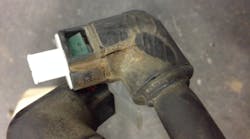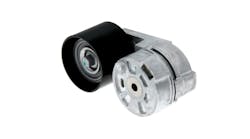Fleets have a different set of challenges to navigate as temperatures drop and road conditions become a factor in the fall and winter season. Maintaining critical vehicle systems before seasonality sets in can help to maximize vehicle investment and uptime.
A system-centered approach to inspection and replacement will help ensure that vehicles are prepared for the season. Because all of the parts in a system are engineered to work in concert and wear at about the same rate, inspect and repair the full system instead of just a single part.
Prepare vehicles now with these best practices.
ABDS
Reviewing the critical Accessory Belt Drive System (ABDS) before the cold sets in is a practical way to prevent inconvenient breakdowns. When components wear, they put the entire system at risk. Be sure to check all components of the ABDS system, including the belt, tensioner and idler pulleys.
Most belts on today’s commercial vehicles are made of EPDM (ethylene propylene diene monomer) material. While it lasts considerably longer than older belts constructed with chlorinated rubber (Neoprene), EPDM belts don’t exhibit traditional signs of wear. Consequently, a simple visual inspection usually can’t determine if a belt is at or near failure.
As an EPDM belt wears, the material is lost in the valleys of the ribs, making the space between ribs wider. This results in poor performance, such as reduced wedging force between the belt and pulley. This can lead to belt slip, noise and hydroplaning, which causes severe vibration and a reduced ability to transmit power, often leading to inconsistent accessory performance.
A simple way to check for belt wear is to use the Gates Belt Wear Gauge. It can be obtained for free at www.gates.com.
Tensioner
An integral part of the ABDS is the tensioner – a device designed to maintain consistent tension on the belt. With a loss of tension, belt slip and heat can occur, and that can lead to premature belt failure.
A tensioner can cycle as much as a billion times every 100,000 miles, essentially wearing out the internal dampener. For a complete system repair, inspect and replace the tensioner and belt at the same time.
Also, check that the idler pulleys smoothly connect the belt to the system. Worn pulleys can also misalign and cause system performance issues.
SCR
Diesel engines that use selective catalytic reduction (SCR) technology require special attention during the winter months. Freezing temperatures and harsh winter road conditions can wreak havoc on SCR systems, so it is especially important to maintain components to ensure optimal vehicle performance.
High-quality hoses are necessary to circulate the diesel exhaust fluid (DEF) – which has a freezing temperature of 12 degrees F – required by SCR systems. It is critical to inspect all hoses in the SCR system to ensure that they are able to heat DEF quickly and uniformly. Gates’ design for SCR assemblies have a carbon fiber heating system that allows for more uniform fluid heating throughout the hose compared to heated-wire designs.
Equally important is to ensure that the hose end connectors are maintained and protected. Field tests have shown that moisture ingression can cause SCR assembly failure due to corrosion of electrical connections. Any cracking of connector ends indicates the immediate need for hose replacement before wet winter driving. Gates SCR assemblies have special thermoplastic over-molds to protect electrical connections against moisture and corrosion.
If the hose you are replacing is the same age as the other two, a combined replacement is recommended for complete repair on the SCR system.
Keeping up with SCR system maintenance will ensure that it operates at optimal performance.
Cooling System
A vehicle’s cooling system can help prevent damage to the engine during extremely cold weather. Ensure the cooling system is operating at peak performance by reviewing all system components, including the radiator, tank cap, thermostat, water pump, radiator hoses and clamps.
Radiator damage, improper coolant mix or blockage can diminish the system’s ability to cool the engine.
Hoses wear from the inside out and can be difficult to visually inspect. If other critical cooling system components are being replaced, it makes sense to replace coolant hoses as well to ensure a complete repair.
A proactive, system-smart approach to vehicle maintenance can help fleets prepare for the challenges of winter, protect vehicles from inconvenient breakdowns and expensive repairs and maximize uptime.
Matt Cleveland is the sales engineer for the heavy duty market for Gates Corporation (www.gates.com). It is the world’s leading manufacturer of power transmission belts and a premier global manufacturer of fluid power products.



